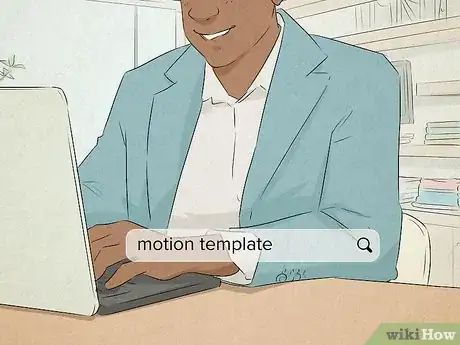This article was co-authored by wikiHow staff writer, Jennifer Mueller, JD. Jennifer Mueller is a wikiHow Content Creator. She specializes in reviewing, fact-checking, and evaluating wikiHow's content to ensure thoroughness and accuracy. Jennifer holds a JD from Indiana University Maurer School of Law in 2006.
wikiHow marks an article as reader-approved once it receives enough positive feedback. In this case, 100% of readers who voted found the article helpful, earning it our reader-approved status.
This article has been viewed 415,985 times.
Learn more...
A board of directors is the governing body of a business, organization, or group. If you want the board to take a particular action, you need to make a motion at a board of directors meeting. Most boards follow some version of Robert's Rules of Order, which outlines the procedure for making a motion.[1]
Steps
Writing Your Motion
-
1Review your group's rules. While most boards of directors meetings are conducted according to some version of Robert's Rules of Order, some boards may have their own specifics. Understanding the specific rules for your group is essential if you want your proposal to be heard and taken seriously.[2]
- Most groups have a written copy of their rules. They may be published on the group's website. If not, talk to the person who takes the minutes of the board meetings – they usually have a copy.
- Find out if you have to tell anybody about your motion before you present it, and if you are required to submit any written documentation of your motion.
- If you've never been to a board meeting, make it a point to go to one before you present your motion, if possible. You can watch others make motions to become more familiar with the procedure.
-
2Check for a form or template. If you are required to submit your motion in writing, your group may have a specific form that you're supposed to use. Some groups may have basic templates to guide you, even if you're not required to use them.[3]
- The form may be published on the group's website. The secretary or another person who takes the minutes of the board meetings also may be able to help you.
- In the absence of a form or template, structure your written motion so that it includes a title, space for a brief description of the motion, and a proposed resolution.
Advertisement -
3Decide what type of motion you want to make. There are four basic types of motions: main, subsidiary, privileged, and incidental motions. The type of motion you want to make will determine in part how your motion is worded and structured.[4]
- Main motions and privileged motions are both unrelated to any other business and must be brought on their own. Subsidiary and incidental motions relate to another matter of business already before the board, so you typically wouldn't have the opportunity to write these out ahead of time.
- Your group may have specific rules for introducing a main motion. For example, you may need to notify the presiding officer of your motion within 24 hours before the meeting takes place.
-
4Use clear and concise wording. Motions typically are brief, and describe exactly what action you want the board to take, or what position you want the board to affirm. Use active language and make every word count.[5]
- On the one hand, you want to include all relevant details. On the other hand, you don't want to be too wordy. Try to strike a happy medium but make sure you've included anything essential.
- If you have enough time to prepare, it can be helpful to have someone else look over your motion and see if anything can be cut out of it.
-
5Be as specific as possible. If your motion is vague, you can significantly decrease the likelihood that the motion will pass. Board members are unlikely to vote for a motion if they don't understand what it means, or if it could be interpreted in multiple ways.[6]
- In general, you want to leave as little room for interpretation as possible. For example, if you want to move that your homeowners' association switches from ABC Landscaping to XYZ Landscaping, you want to list those companies specifically.
Presenting Your Motion
-
1Stand or raise your hand. Before you make your motion, you must be recognized and allowed to speak by the presiding officer. The protocol varies among groups, but generally you will wait until the presiding officer asks for motions and then either stand or raise your hand.[7]
- Generally the presiding officer will open the floor to motions by asking "Is there any new business?"
-
2Wait to be recognized. When the presiding officer is ready to hear your motion, they'll point to you or address you by name and let you know that you have the floor. Depending on the procedural conventions of your group, you may stand at your seat or move to the front of the room.[8]
- In smaller, more informal groups, such as where people are seated around a single table, you may not need to stand or move at all.
-
3State your purpose. When the presiding officer recognizes you, address them by their formal title (typically "Chair" or "President"). If you're unsure of their official title, listen to what they use when they recognize you. They typically will refer to themselves in the third person (for example, "The Chair recognizes Mr. Malarky").[9]
- After the official title, refer to the presiding officer as either "Mr." or "Madam," whichever they prefer.
- Start by saying "I would like to propose a motion." In some groups it may be customary for the presiding officer to acknowledge your purpose and give you permission to continue. In others, you may simply continue stating your motion.
- Depending on the rules or customs of your group, you may need to describe the type of motion you want to make here.
-
4Introduce your motion. Once you are cleared to proceed, begin by saying "I move" and then state the action that you want the board to take. If you've written your motion, you can read directly from your written document.[10]
- Your motion should always be stated affirmatively. Tell the board what you think it should do, not what it should not do.
- For example, you might say "I move that the Board cancels the contract with ABC Landscaping and instead hires XYZ Landscaping."
-
5Wait for someone to second your motion. Most motions must be seconded by another member of the board. This helps ensure that the board doesn't spend meeting time considering a motion that is only important to one person.[11]
- The presiding officer typically will ask if anyone seconds the motion. Someone will stand or raise their hand and say "I second the motion" or simply "I second."
- In most groups it is commonplace for you to already have a second lined up. Talk to others in the group before the board meeting and tell them about your motion. Find out if someone is willing to second it.
Reaching a Resolution
-
1Listen to the presiding officer's statement of the question. After you've stated your motion, the presiding officer will restate your motion as a question to the rest of the board. This is called "stating the question," and officially opens your motion for consideration by the board.
- For example, if you made the motion to switch landscapers, the presiding officer might say "Should the board cancel our contract with ABC Landscaping and hire XYZ landscaping?" This question will always be a yes/no question.
-
2Argue for your motion. After the presiding officer finishes stating the question, they typically will give you the opportunity to explain why you made that proposal. You typically have the floor for a limited period of time.[12]
- Address your comments to the board as a whole, not the presiding officer directly. Explain whatever you feel is necessary. Now is the time to convince the other board members to side with you.
- Generally you should avoid making personal comments or addressing any specific board member individually, unless it is absolutely necessary to do so in the context of the motion.
-
3Participate in the discussion and debate. Once you've finished explaining the reasons for your motion, the presiding officer will open the floor to debate. Discussion may be spirited and open, or it may follow a strict, more formal procedure.[13]
- Generally, Robert's Rules dictate that each person who speaks should only speak once or twice to allow everyone who wants to speak the opportunity to do so. Your group may have a more relaxed and open procedure.
-
4Consider secondary motions. Any board member may make subsidiary, privileged, or incidental motions. If those motions are raised, you are expected to yield the floor to the person making that motion. That motion will be considered by the board before they return to your motion.
- If a secondary motion is made, it will go through the same procedure as your motion did. Typically you don't have the opportunity to change your motion based on the secondary motion, but you can make a new motion.
-
5Vote on the motion. Once the presiding officer determines that debate or discussion of the motion should be over, they'll call for a vote. There are several methods of voting, but typically it will be either as a show of hands or by voice.
- The presiding officer calls for affirmative votes first, and counts them. If the affirmative votes are a clear majority of the members, they won't ask for negative votes.
- If there aren't enough affirmative votes, the motion doesn't pass. You may be able to bring it up again, or propose an amended form. This varies depending on the rules of your group or organization.
-
6Help draft the resolution. If your motion passes, you may be expected to provide a draft of the motion that you proposed the board adopt. If you were required to submit a written copy of your motion, you may have to include a draft of the proposed resolution along with it.[14]
- Even if you aren't required to submit a written copy of your motion, it's a good idea to write up a draft of the resolution. If your motion passes, you can offer your draft to the presiding officer.
Community Q&A
-
QuestionHow do you take back a motion?
 Community AnswerYou take back a motion by asking the chair for permission to withdraw your motion. The chair will put it to a vote and if the majority of the group agrees, your motion will be withdrawn.
Community AnswerYou take back a motion by asking the chair for permission to withdraw your motion. The chair will put it to a vote and if the majority of the group agrees, your motion will be withdrawn. -
QuestionCan the secretary of a church board make a motion?
 Community AnswerAnyone member of the board can make a motion. The secretary of the board is a member of the board and therefore would be permitted to make a motion.
Community AnswerAnyone member of the board can make a motion. The secretary of the board is a member of the board and therefore would be permitted to make a motion. -
QuestionIf you make a motion to approve an item, can you then vote against it?
 Community AnswerUnder Robert's Rules, you are free to vote against your own motion. However, you cannot speak against your own motion in open debate. You also have the option of asking permission to withdraw your motion. The chair will put it to a vote, and if the whole group agrees, your motion will be withdrawn.
Community AnswerUnder Robert's Rules, you are free to vote against your own motion. However, you cannot speak against your own motion in open debate. You also have the option of asking permission to withdraw your motion. The chair will put it to a vote, and if the whole group agrees, your motion will be withdrawn.
References
- ↑ http://empowerla.org/wp-content/uploads/2012/04/Condensed_Roberts_Rules_of_Order.pdf
- ↑ https://soasunion.org/democracy/writeamotion/
- ↑ https://soasunion.org/democracy/writeamotion/
- ↑ http://www.robertsrules.org/rulesintro.htm
- ↑ https://soasunion.org/democracy/writeamotion/
- ↑ https://soasunion.org/democracy/writeamotion/
- ↑ http://empowerla.org/wp-content/uploads/2012/04/Condensed_Roberts_Rules_of_Order.pdf
- ↑ http://empowerla.org/wp-content/uploads/2012/04/Condensed_Roberts_Rules_of_Order.pdf
- ↑ http://www.robertsrules.org/rulesintro.htm
About This Article
To make a motion at a board of directors meeting, start by raising your hand or standing when the presiding officer opens the floor to motions. Once the presiding officer gives you the floor, address them by their formal title and state that you'd like to propose a motion. Then, introduce your motion by saying "I move" followed by your proposal. For example, you could say "I move that the board cancels the contract with ABC Landscaping." To learn how to prepare your motion so you're ready to present it at a meeting, keep reading!



















-Step-23.webp)






















-Step-23.webp)


































